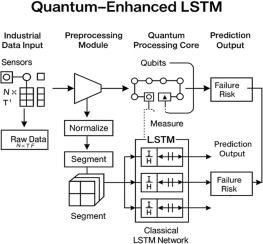用于工业物联网系统预测性维护的量子增强LSTM
IF 1.9
Q2 MULTIDISCIPLINARY SCIENCES
引用次数: 0
摘要
我们提出了一种结合量子计算和LSTM神经网络能力的工业物联网系统预测性维护创新解决方案。我们的概念以混合量子-经典架构为指导,以促进量子计算利用高维工业传感器测量,同时通过特定量子通道保留关键的时间关系。通过结合量子电路的代表性独创性,以及经典lstm的基于序列的建模,QE-LSTM具有独特的定位,可以处理来自工业传感器的复杂时间序列。我们方法论的核心是以下独特元素:•集成量子和经典技术的协作框架,允许量子计算机管理行业中高维传感器数据的复杂分析。•量子通道设计旨在最大限度地减少时间序列工业测量中的时间依赖性,从而最大限度地提高序列分析的质量。•在ODS后向预测下,QE-LSTM将F1在SECOM上提高了4-5个百分点,并降低了C-MAPSS上的RMSE和NASA分数;移民趋势是一致的(表1、表2)。表1。datasetmodelaccuracyprecisionrecallf1aucsecomlstm0.8640.8420.8090.8250.902 cnn - lstm0.8780.8620.8240.8420.914 eq -LSTM (sim)0.9040.8920.8610.8760.938 eq -LSTM(硬件)0.8960.8810.8500.8650.930 imdlstm0.9060.8830.8620.8720.943 cnn - lstm0.9130.8910.8690.8800.949 eq -LSTM (sim)0.9280.9080.8880.8980.960 eq -LSTM (sim) vs LSTM F1 δ: SECOM +5.1 pp, imd +2.6 pp;配对t检验p <; 0.01。表2。规则预测性能指标。MetricClassical LSTMCNN-LSTMQE-LSTM (sim) q - lstm (hardware)Improvement vs LSTMRMSE↓20.619.418.118.712.1% MAE↓15.414.613.814.310.4% NASA Score↓69264860362112.8 %*如果所有指标的值都较小,则评价为正。分数是一个突出的指标,因为它倾向于严重惩罚迟来的预测(这与有效的维护计划高度相关)。在轴承故障检测的应用中,QE-LSTM在SECOM上的F1比经典基线提高了4-5个pp,在imd上也有类似的提高;C-MAPSS (RUL)结果显示RMSE和NASA得分一致下降。本文章由计算机程序翻译,如有差异,请以英文原文为准。

Quantum-enhanced LSTM for predictive maintenance in industrial IoT systems
An innovative solution for predictive maintenance in IIoT systems combining quantum computing with the proficiency of LSTM neural networks is proposed by us. Our concept is guided by a hybrid quantum-classical architecture to facilitate quantum computing to exploit high-dimensional industrial sensor measurements while preserving crucial temporal relationships through particular quantum channels. Through the combination of the representational ingenuity of quantum circuits, along with the sequence-based modelling of classical LSTMs, QE-LSTM is uniquely positioned to handle complicated time series coming out of industrial sensors. At the heart of our methodology are the following unique elements:
- •A collaborative framework integrating quantum and classical technologies allowing for the quantum computer to manage the complex analysis of high dimensional sensor data in the industry.
- •Quantum channel designs were aimed at minimizing temporal dependencies in temporal series industrial measurements, thereby maximizing the quality of sequential analysis.
- •Under ODS hindcasting, QE-LSTM improved F1 by 4–5 percentage points on SECOM and reduced RMSE and NASA Score on C-MAPSS; trends were consistent on IMMD (Table 1, Table 2).
Table 1. Performance comparison across datasets.
Dataset Model Accuracy Precision Recall F1 AUC SECOM LSTM 0.864 0.842 0.809 0.825 0.902 CNN-LSTM 0.878 0.862 0.824 0.842 0.914 QE-LSTM (sim) 0.904 0.892 0.861 0.876 0.938 QE-LSTM (hardware) 0.896 0.881 0.850 0.865 0.930 IMMD LSTM 0.906 0.883 0.862 0.872 0.943 CNN-LSTM 0.913 0.891 0.869 0.880 0.949 QE-LSTM (sim) 0.928 0.908 0.888 0.898 0.960 QE-LSTM (sim) vs LSTM F1 deltas: SECOM +5.1 pp, IMMD +2.6 pp; paired t-test p < 0.01.Table 2. RUL prediction performance metrics.
Metric Classical LSTM CNN-LSTM QE-LSTM (sim) QE-LSTM (hardware) Improvement vs LSTM RMSE ↓ 20.6 19.4 18.1 18.7 12.1 % MAE ↓ 15.4 14.6 13.8 14.3 10.4 % NASA Score ↓ 692 648 603 621 12.8 % * Evaluations are positive if all the metrics have smaller values. Score is a metric that stands out because of the tendency to heavily penalise late predictions (which is highly relevant to effective maintenance planning).
求助全文
通过发布文献求助,成功后即可免费获取论文全文。
去求助
来源期刊

MethodsX
Health Professions-Medical Laboratory Technology
CiteScore
3.60
自引率
5.30%
发文量
314
审稿时长
7 weeks
期刊介绍:
 求助内容:
求助内容: 应助结果提醒方式:
应助结果提醒方式:


